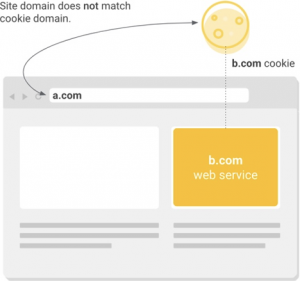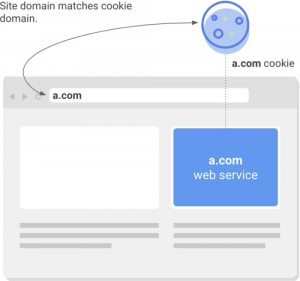What is Chrome 80?
Released by Google, on Feb 4th this year, Chrome 80 is the latest in a rapid series of browser updates focused on privacy and security.
Why should I care?
The standout feature in Chrome 80 is its move to strictly limit cookies sharing traffic and users, and operating cross-site. This is the ‘SameSite’ setting you may have seen already.
Right now the setting on a site can be set ‘SameSite=None‘, ‘SameSite=Lax‘ or ‘SameSite=Strict‘, to manage whether cookies are exposed. However, Chrome 80 is taking a ‘secure-by-default’ approach, and protecting all cookies from external access, by setting the ‘SameSite=Lax‘ flag by default.
So, Chrome 80 stops a user being sent from one site, where they have actively journeyed and accepted tracking, to another URL and being tracked across the domain switch. This includes restricting tracking where there are multiple URLs present on a single website.

When an external resource on a web page accesses a cookie that does not match the site domain, this is cross-site or “third-party” context.

When a resource on a web page accesses a cookie that matches the site the user is visiting, this is same-site or “first party” context.
Chrome 80 is also going to stop traffic to insecure domains, operating using HTTP. Therefore, the key to maintaining a healthy tracking process after the Chrome 80 release, is to use only HTTPS (whereby the data being exchanged is encrypted and secured) and first party tracking.
Should I be concerned about my business?
If you’re working with Webgains, then no, absolutely not.
Since before the advent of GDPR, in early 2018, Webgains has been committed to first party tracking only and moving to using only HTTPS links. All advertisements we provide to publishers are HTTPS and all tracking via Webgains used HTTPS endpoints.
We began the transition of all advertisers to first party tracking in early 2018, and our fully bespoke tracking code is constantly future- proofing, so you need make no updates to your integration, and you should expect no changes in reporting after Feb 4th.
Webgains development teams are rolling out a SameSite update, to ensure consistency across all browsers, and will continue to monitor traffic and reporting. If you have any concerns or questions whatsoever, please contact your Account Manager in the first instance.
Is there anything else I should do?
We do recommend that all Publishers and Advertisers use SSL, as a method of ensuring the data they share is secured through an encrypted channel. This is best practise and effectively turns a website from HTTP to HTTPS.
Outside of the Webgains eco-system there may be places where you are using third-party tools or partners, to optimise your sales. There are resources to help you keep your site in line with Chrome 80’s changes, and others, via the Chromium blog or Webkit blog.
You also don’t need to change your ads. All Webgains ads are hosted via HTTPS (SSL) and have been since 2019.
What is the future of tracking at Webgains?
Webgains is committed to driving innovation forward, with both a GDPR and privacy-minded focus to our tracking. Wherever possible we take-action on your behalf, to make sure all tracking uses the best forms of security and maintains a commitment to privacy. The directives on privacy across browsers is changing constantly, which means it’s important to keep pace with the new standards.
We continue to push new changes to our tracking, our platforms and our security processes, more of which you will read in this blog.

